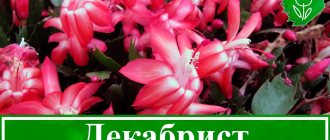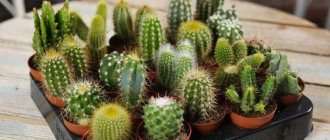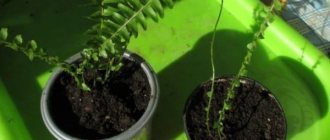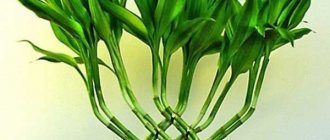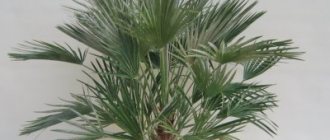The familiar “rabbit chill” has lost its position in floristry, but has gained completely new popularity as an indoor plant. The most modest and popular type of asparagus, Asparagus Sprenger, is a far from inconspicuous plant. Unpretentious and easy to care for, it allows you to bring unique openwork and airy cascades of greenery into your home, which will not seem too massive even in the most modest room. This is a unique species with special shoot arches and a completely friendly character.
Sprenger's asparagus is the best option for cascading gardening. © MiltonsGrdnMenagerie
What does Sprenger asparagus look like, what family does it belong to?
According to the generally accepted classification, asparagus belongs to the Asparagus family of plants. It is an evergreen perennial and is represented by a large number of species - about 300 in total. Among the most popular varieties, well suited for indoor keeping, is Sprenger's asparagus. Other names for this flower are asparagus densiflora, or densely flowered.
Asparagus sprengeri
The plant consists of several long flexible stems that form a bush. The stems can reach 1.5 m in length. They are thin, so they bend towards the ground. Due to this feature, densiflora is often used as a hanging cascade plant.
Asparagus sprengeri has branches covered with small cladodes, the size of which does not exceed 2.5 cm. Cladodes are small narrow leaves that resemble pine needles in appearance, which gives the plant an openwork airy appearance.
During flowering, the branches are covered with abundant small flowers, in place of which red berries are then formed. One seed ripens in each.
Important! The berries contain toxic substances, so you should absolutely not taste them.
Asparagus Sprenger (berries)
Common varieties
In addition to densely flowered asparagus, there are several more representatives of this species:
- Pinnate. It is characterized by a stem length of up to 1 m. The branches are covered with small needle-shaped leaves, which makes them look like spruce.
- Mayer. A large bush that can grow several meters wide. The branches are covered with a large number of cladonae, so they appear fluffy. Due to its appearance, the plant is often called foxtail.
- Crescent. A small shrub with branches that, with good care, can reach 4 m in length. Crescent asparagus has large oblong leaves that resemble a sickle.
Medicinal properties
Some types of asparagus are used in folk medicine. They affect the body in several ways:
- relieve pain;
- cleanse the blood;
- have a mild diuretic effect;
- dilate blood vessels;
- calm down.
Photo gallery
Old branches begin to “go bald” over time, gradually losing their cladodes. In May-June, inflorescences containing small white flowers appear in the axils of the leaf scales. After flowering, bright red berries are formed in place of the bud.
Features of plant care at home
Asparagus takes root well at home. If simple recommendations are followed, the shrub produces a large amount of greenery and blooms often.
Temperature
Asparagus pinnate - home care
The plant is heat-loving, but extreme heat is undesirable for it. The flower grows best at a temperature of +18…+24 ℃. It is not recommended to place the semi-shrub close to heating devices or in drafts. Both will negatively affect the appearance of densiflora.
Lighting
For active growth and flowering, light is extremely important for this plant, but direct sunlight causes burns. It is best to place asparagus on the windowsill if the room faces east or northeast. If the side is south, then the flowerpot is removed away from the window.
Watering
Asparagus densely flowered is demanding when it comes to watering. In summer, it should be regularly watered with water at room temperature. If it is hot and air humidity is low, then watering can be repeated every day. The soil in the flowerpot should always be moist.
Additional Information! The water remaining in the pan after watering must be removed.
Spraying
During the hot period, to maintain a good microclimate, the plant should be sprayed twice a day. You need to make sure that the water is not cold.
Humidity
There are no special requirements for this indicator. It is enough to maintain normal humidity in the room. If the flower is located next to a radiator or other heating device, place a container with wet stones next to it.
Priming
Loose soil with neutral acidity is best suited for Sprenger asparagus at home. When using store-bought soil, choose one that is intended for decorative deciduous plants.
When preparing the soil yourself, several components are mixed in equal quantities: peat soil, leaf soil and turf soil. A little river sand is added to this composition.
Feeding
You need to fertilize the soil during the flower growth period 2 times a month. As a top dressing, universal mineral compositions designed for indoor plants are used.
Reproduction methods
Asparagus propagates by planting seeds, dividing the bush into parts, and planting cuttings cut from the main plant. You can sow seeds for propagation throughout the year. Within a month you will be able to admire the seedlings.
At home, the seed method is most often used to propagate asparagus. The seeds are first germinated by placing them in sawdust. Seed material in sawdust should be placed in a warm place. It will be well saturated with moisture. It is important to mix the seeds regularly. Sprouted seeds are planted in the ground along with sawdust. The seedlings should close together. If this happens, they can be planted in pots.
Dividing the bush is considered a quick way to propagate asparagus, but not all plants can take root successfully. For this procedure, you should remove the bush from the pot and carefully divide it into parts. Each division should have roots with two or three nodules.
Cuttings are carried out by cutting cuttings and rooting them for one and a half months. Branches rooted in water or sand are planted in prepared soil. When rooting cuttings in water, care must be taken to ensure that they do not rot. For this purpose, you can add activated carbon or another similar product to a glass of water.
When and how does it bloom
In an apartment, Sprenger's asparagus blooms often and profusely; it is enough to provide it with good care.
Asparagus blooms
Types of flowers
Flowers appearing on branches can be either male or female. The flowers are small, milky peach in color.
Flower shapes
Small flowers are not located singly on the branches - they are collected in axillary paniculate-type inflorescences.
Flowering period
The flowering period lasts a long time. The first inflorescences appear in late spring or early summer. Flowering usually ends in autumn.
Trimming
Asparagus pruning is carried out for several purposes:
- eliminate damaged diseased branches;
- make the bush thicker.
The peculiarity of this flower is that the cut branches will no longer grow in length. In this case, the growth of dormant buds at the base of the bush is activated.
Description of the appearance of asparagus and its origin
Asparagus is a delicate and elegant plant, well known since the Soviet times. At that time, many establishments that were heavily visited by people were decorated with it, and asparagus was also popular in indoor floriculture. But with the arrival of the Dutch variety on our flower market, the plant began to be gradually forgotten. But the flower deserves to be once again interested in not only experienced flower growers, but also beginners.
Asparagus - a classic of home gardening
Asparagus has many faces. Its species are represented by evergreen perennial subshrubs with developed underground rhizomes and branched stems, woody vines or herbaceous plants.
Asparagus has a powerful underground root consisting of many tubers.
Root part of asparagus
The stems are flexible and have branches. Asparagus does not have leaves as such. Instead, numerous branches or cladodes collected in bunches are located on the branches. They are very needle-like and seem prickly in appearance, but in fact they are very soft and delicate.
Asparagus stems are flexible and have many branches.
The flowers are small - solitary or collected in inflorescences. They are painted white, less often pink or beige.
The fruits look like red berries. Inside the fruit there are one or more seeds covered with a thick black skin. The berries are poisonous, so if you have children or animals in the house, you should take precautions!
After pollination of asparagus flowers, fruits ripen - berries.
Asparagus belongs to the Asparagus family, which unites not only decorative, but also medicinal and edible species. The plant is distributed almost throughout the world - on the African continent, Asia, America and Europe. But mostly it prefers places with a dry climate.
The rhizome, which accumulates moisture for future use, helps to survive long periods of drought.
Growing asparagus at home is not difficult. The plant is undemanding in terms of maintenance conditions. Unless watering and lighting should be approached with special responsibility. And one more nuance should be taken into account - some types of asparagus can grow greatly and you need to allocate more space for them.
Asparagus is often used as a component of landscape design. The plant is a wonderful element of decoration and landscaping of cozy courtyards and terraces. Florists decorate bouquets and flower arrangements with asparagus sprigs. The plant looks very impressive in hanging baskets or flower pots.
How does Sprenger's asparagus reproduce?
There are three ways to plant Sprenger asparagus:
- Separation of part of the rhizome with active buds.
- Seeds.
- By cuttings.
Germination of seeds
For propagation by seeds, purchased grains or berries picked from an already mature bush are suitable. Before planting, the seed is strengthened by soaking in a weak solution of potassium permanganate. Planting is carried out in this way:
- Seeds are planted in prepared moist soil (the distance between them is about 3 cm).
- Cover the box with film. This will help maintain the same temperature at all times.
- Periodically, the greenhouse is ventilated and sprayed with water.
Shoots will appear after 18-25 days.
Rhizome division
Perform the division as follows:
- A part of the rhizome is separated from the mother bush, which must have several buds and shoots.
- Each individual piece of rhizome is planted in prepared and pre-moistened soil.
Propagation of asparagus by rhizome
Cuttings
To plant a flower in this way, follow several steps:
- At the beginning of spring, shoots are cut from the bush. The length of the cuttings should reach 15-20 cm.
- Layers are buried in wet sand. To preserve heat and moisture, the container is covered with film and periodically ventilated.
- After the roots appear, the cuttings are planted in flowerpots.
Transfer
Young flowers are transplanted every year into pots that correspond to the development of the root system:
- shake off the entire earthen lump
- inspect the plant for rot or damage
- if problem areas are found, they must be removed
- healthy roots need to be shortened a little
Adult Asparagus is replanted no more often than after 3 years.
The plant should not feel cramped in the pot
Possible problems in cultivation and diseases
Asparagus Spregneri may lose its attractive appearance for several reasons:
- improper care;
- diseases of ornamental plants;
- damage by insect pests.
Drops buds and leaves
If cladodes and flowers dry out and begin to crumble, you should pay attention to the peculiarities of growing Sprenger asparagus and care at home. Often the plant loses leaves due to lack of light, severe drought or drafts.
The leaves are turning pale
Discoloration of shoots is usually caused by overwatering or lack of nutrients in the soil.
The lower leaves fall off
If the lower leaves begin to fall off, fungal diseases may be the cause. In this case, the bush should be treated with an antifungal compound, for example, Discorm or Gamair.
Top 10 asparagus varieties for home cultivation
| Variety | Peculiarities |
| Asparagus Plumosus or Asparagus Setaceus | A very branched specimen. The branches are similar to spruce, and the shoots are used as food, and you can eat them raw or boiled. |
| Asparagus Sprenger (sprengeri), Dense-flowered densiflorus or densiflorus (densiflorus) | Ornamental plant. The stems can grow up to one and a half meters. It tolerates cutting off excess parts well. |
| Medioloides | It does not have root bulbs. Consumed fresh. It is also used as a raw material for the production of aspargine. |
| Crescent falcatus | An elegant-looking decorative vine that can be used to decorate various structures and interiors. |
| Racemosus | The so-called “climbing” subshrub, long, “captivating” and decorating large spaces. |
| Ordinary or pharmacy (officinalis) | Has vasodilating, laxative, diuretic properties. Used to produce corresponding types of medicines. |
| Meyer's asparagus (meyeri) | A gorgeous curly plant, reaches half a meter in height and six meters in width. |
| Umbellatus, umbrella-shaped | This is a very beautiful fluffy greenery that can be used to decorate a bouquet of flowers. Has a decorative purpose. |
| The thinnest (benuissimus) | A very elegant variety with shoots up to one and a half meters. Creates a feeling of coziness and comfort. |
| Myriocladus | An ideal option if there is little space, but you want to have unpretentious homemade greens. |
Sometimes certain varieties are confused with ferns - for example, Meyer and Sprenger asparagus. And they try to associate certain signs and superstitions with them. However, they have nothing to do with ferns. Also, they should not be confused with succulents - they are a separate species.
There is another interesting variety - Nanus asparagus, such a cute mini-flower, the most dwarf in its group. But it is a little more capricious to care for, so we do not recommend planting it as a house plant.
Pests
Asparagus densely flowered Sprenger is often affected by the following insects:
- scale insect;
- fungus gnat;
- aphid;
- spider mite;
- scale insects;
- trippy
Additional Information! To control pests, it is recommended to treat the plant with insecticides.
Asparagus densiflora is an ornamental plant with an unusual appearance. It can be grown both indoors and outdoors. In the latter case, it is taken into the warmth for the winter. This African flower is easy to care for and can be propagated well. For this reason, it is recommended for beginner gardeners.


